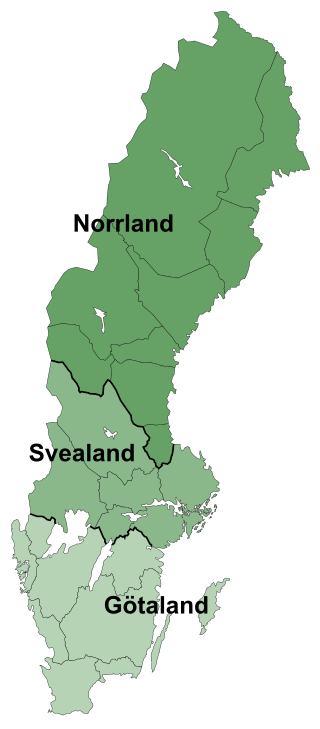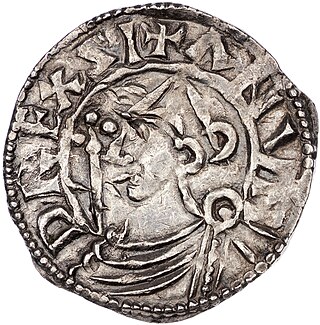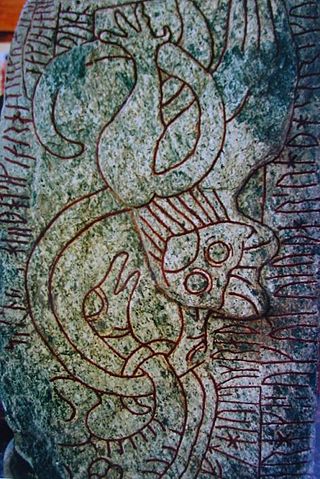
The Geats, sometimes called Goths, were a large North Germanic tribe who inhabited Götaland in modern southern Sweden from antiquity until the Late Middle Ages. They are one of the progenitor groups of modern Swedes, along with Swedes and Gutes. The name of the Geats also lives on in the Swedish provinces of Västergötland and Östergötland, the western and eastern lands of the Geats, and in many other toponyms.

The Swedes were a North Germanic tribe who inhabited Svealand in central Sweden and one of the progenitor groups of modern Swedes, along with Geats and Gutes. They had their tribal centre in Gamla Uppsala.

Götaland is one of three lands of Sweden and comprises ten provinces. Geographically it is located in the south of Sweden, bounded to the north by Svealand, with the deep woods of Tiveden, Tylöskog and Kolmården marking the border.

The lands of Sweden are three traditional and historical regions of the country, each consisting of several provinces. The division into lands goes back to the foundation of modern Sweden, when Götaland, the land of the Geats, merged with Svealand, the land of the Swedes, to form the country, while Norrland and Österland were added later. The lands have no administrative function but are still seen by many Swedes as an important part of their identity.

Swedish pre-history ends around 800 AD, when the Viking Age begins and written sources are available. The Viking Age lasted until the mid-11th century. Scandinavia was formally Christianized by 1100 AD. The period 1050 to 1350—when the Black Death struck Europe—is considered the Older Middle Ages. The Kalmar Union between the Scandinavian countries was established in 1397 and lasted until King Gustav Vasa ended it upon seizing power. The period 1350 to 1523 – when king Gustav Vasa, who led the unification of Sweden in the Swedish War of Liberation, was crowned – is considered the Younger Middle Ages. During these centuries, Sweden gradually consolidated as a single nation.
The Götaland theory is a view which challenges established history and archaeology, and claims that the foundation of Sweden occurred not in Eastern Sweden, but in the province of Westrogothia (Västergötland). The adherents of this idea use wide-ranging methods, from controversial ones, such as dowsing and asking mediums to contact the dead, to more conventional methods such as etymology, but also claim that the established academic material consists of lies and forgeries. Although well known in Sweden and fervently preached by its adherents, it has never been accepted by scholars.

Olof Skötkonung, sometimes stylized as Olaf the Swede, was King of Sweden, son of Eric the Victorious and, according to Icelandic sources, Sigrid the Haughty. He succeeded his father in c. 995. He stands at the threshold of recorded history, since he is the first Swedish ruler about whom there is substantial knowledge. He is regarded as the first king known to have ruled both the Swedes and the Geats. In Sweden, the reign of king Olov Skötkonung is considered to be the transition from the Viking age to the Middle Ages, he was the first Christian king of the Swedes, who ruled central Sweden. Norse beliefs persisted in parts of Sweden until the 12–13th century.

Eric the Victorious was a Swedish monarch as of around 970. Although there were earlier Swedish kings, he is the first Swedish king in a consecutive regnal succession, who is attested in sources independent of each other, and consequently Sweden's list of rulers usually begins with him. His son Olof Skötkonung, however, is considered the first ruler documented to definitely have been accepted both by the original Swedes around Lake Mälaren and by the Geats around Lake Vättern. Adam of Bremen reports a king named Emund Eriksson before Eric, but it is not known whether he was Eric's father. The Norse sagas' accounts of a Björn Eriksson are considered unreliable.

Scandza was described as a "great island" by Gothic-Byzantine historian Jordanes in his work Getica. The island was located in the Arctic regions of the sea that surrounded the world. The location is usually identified with Scandinavia.

The Battle of Brávellir or the Battle of Bråvalla was a legendary battle, said to have taken place c. 770, that is described in the sagas as taking place on the Brávellir between Sigurd Hring, king of Sweden and the Geats of Västergötland, and his uncle Harald Wartooth, king of Denmark and the Geats of Östergötland.

The House of Munsö, also called the House of Björn Ironside, the House of Uppsala or simply the Old dynasty, is the earliest reliably attested royal dynasty of Sweden, ruling during the Viking Age. None of the names suggested for the dynasty are universally accepted and most are problematic; the name "House of Munsö" derives from a questionable and speculative theory that they would have ruled from the island of Munsö and the name "House of Björn Ironside" derives from the supposed founder of the dynasty, Björn Ironside, who is often seen as a legendary, rather than historical, figure.

Anund Jacob or James was King of Sweden from 1022 until around 1050. He is believed to have been born on 25 July, in either 1008 or 1010 as Jakob, the son of King Olof Skötkonung and Queen Estrid. Being the second Christian king of the Swedish realm, his long and partly turbulent reign saw the increasing dissemination of Christianity as well as repeated attempts to influence the balance of power in Scandinavia. Throughout his reign, he tried to subvert the rising Danish hegemony in Scandinavia by supporting the Norwegian monarchy. He also supported the reign of Yaroslav the Wise in Kievan Rus, his brother-in-law. He is referred to in positive terms in German and Norse historical sources. His reign was one of the longest in Sweden during the Viking Age and Middle Ages.
In Modern English, the name of Sweden is derived from 17th century Middle Dutch and Middle Low German. In Old English, the country was named Swēoland and Swēorīċe ; the latter is cognate with Old Norse Svíaríki. Anglo-Norman of the 12th and 13th centuries used Suane and Swane. In Scots, Swane and Swaine appear in the 16th century. Early Modern English used Swedeland.

Torgny the Lawspeaker is the name of one of at least three generations of lawspeakers by the name Þorgnýr, who appear in the Heimskringla by the Icelandic scholar and chieftain Snorri Sturluson, and in the less known Styrbjarnar þáttr Svíakappa and Hróa þáttr heimska. They were the lawspeakers of Tiundaland, and all lawspeakers in the Swedish kingdom were their subordinates.
Austrfararvísur is a skaldic poem composed by the Icelandic skald Sigvatr Þórðarson c. 1019. It is written in the meter dróttkvætt.
Óttarr svarti was an 11th-century Icelandic skald. He was the court poet first of Óláfr skautkonungr of Sweden, then of Óláfr Haraldsson of Norway, the Swedish king Anund Jacob and finally of Cnut the Great of Denmark and England. His poems are significant contemporary evidence for the careers of Óláfr Haraldsson and Cnut the Great.

The Swedish-Geatish wars refer to semi-legendary 6th century battles between Swedes and Geats that are described in the Anglo-Saxon epic Beowulf. Little has survived of such battles in the Norse sagas, and later 11th century-13th century wars between Swedes and Geats, notably involving the Geatish clans House of Stenkil and House of Sverker, are referred to as Swedish civil wars.

The Danish Census Book or the Danish book of land taxation dates from the 13th century and consists of a number of separate manuscripts. The original manuscripts are now housed in the Danish National Archives (Rigsarkivet) in Copenhagen.

Astrid Olofsdotter was the queen consort of King Olaf II of Norway.















